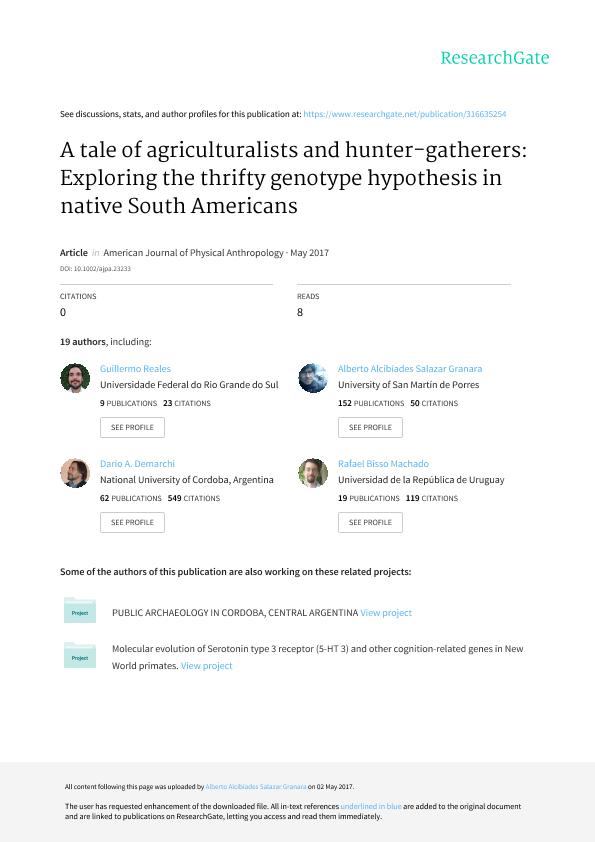Artículo
A tale of agriculturalists and hunter-gatherers: Exploring the thrifty genotype hypothesis in native South Americans
Reales, Guillermo; Rovaris, Diego L.; Jacovas, Vanessa C.; Hünemeier, Tábita; Sandoval, José R.; Salazar Granara, Alcibiades; Demarchi, Dario ; Tarazona Santos, Eduardo; Felkl, Aline B.; Serafini, Michele A.; Salzano, Francisco M.; Bisso Machado, Rafael; Comas, David; Paixão Côrtes, Vanessa R.; Bortolini, Maria Catira
; Tarazona Santos, Eduardo; Felkl, Aline B.; Serafini, Michele A.; Salzano, Francisco M.; Bisso Machado, Rafael; Comas, David; Paixão Côrtes, Vanessa R.; Bortolini, Maria Catira
 ; Tarazona Santos, Eduardo; Felkl, Aline B.; Serafini, Michele A.; Salzano, Francisco M.; Bisso Machado, Rafael; Comas, David; Paixão Côrtes, Vanessa R.; Bortolini, Maria Catira
; Tarazona Santos, Eduardo; Felkl, Aline B.; Serafini, Michele A.; Salzano, Francisco M.; Bisso Machado, Rafael; Comas, David; Paixão Côrtes, Vanessa R.; Bortolini, Maria Catira
Fecha de publicación:
07/2017
Editorial:
Wiley-liss, Div John Wiley & Sons Inc
Revista:
American Journal Of Physical Anthropology
ISSN:
0002-9483
Idioma:
Inglés
Tipo de recurso:
Artículo publicado
Clasificación temática:
Resumen
Objectives: To determine genetic differences between agriculturalist and hunter-gatherer southern Native American populations for selected metabolism-related markers and to test whether Neel's thrifty genotype hypothesis (TGH) could explain the genetic patterns observed in these populations. Materials and Methods: 375 Native South American individuals from 17 populations were genotyped using six markers (APOE rs429358 and rs7412; APOA2 rs5082; CD36 rs3211883; TCF7L2 rs11196205; and IGF2BP2 rs11705701). Additionally, APOE genotypes from 39 individuals were obtained from the literature. AMOVA, main effects, and gene-gene interaction tests were performed. Results: We observed differences in allele distribution patterns between agriculturalists and hunter-gatherers for some markers. For instance, between-groups component of genetic variance (FCT) for APOE rs429358 showed strong differences in allelic distributions between hunter-gatherers and agriculturalists (p = 0.00196). Gene-gene interaction analysis indicated that the APOE E4/CD36 TT and APOE E4/IGF2BP2 A carrier combinations occur at a higher frequency in hunter-gatherers, but this combination is not replicated in archaic (Neanderthal and Denisovan) and ancient (Anzick, Saqqaq, Ust-Ishim, Mal'ta) hunter-gatherer individuals. Discussion: A complex scenario explains the observed frequencies of the tested markers in hunter-gatherers. Different factors, such as pleotropic alleles, rainforest selective pressures, and population dynamics, may be collectively shaping the observed genetic patterns. We conclude that although TGH seems a plausible hypothesis to explain part of the data, other factors may be important in our tested populations.
Palabras clave:
Adaptation
,
Apoe
,
Mode of Subsistence
,
Pleiotropy
Archivos asociados
Licencia
Identificadores
Colecciones
Articulos(IDACOR)
Articulos de INSTITUTO DE ANTROPOLOGIA DE CORDOBA
Articulos de INSTITUTO DE ANTROPOLOGIA DE CORDOBA
Citación
Reales, Guillermo; Rovaris, Diego L.; Jacovas, Vanessa C.; Hünemeier, Tábita; Sandoval, José R.; et al.; A tale of agriculturalists and hunter-gatherers: Exploring the thrifty genotype hypothesis in native South Americans; Wiley-liss, Div John Wiley & Sons Inc; American Journal Of Physical Anthropology; 163; 3; 7-2017; 591-601
Compartir
Altmétricas



